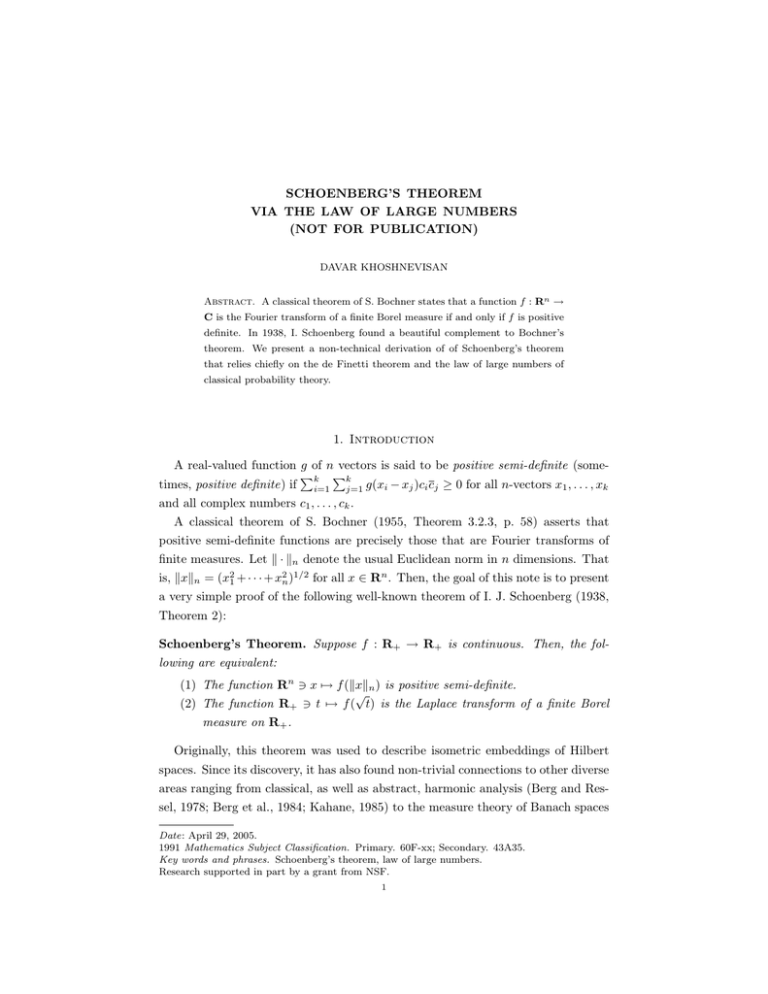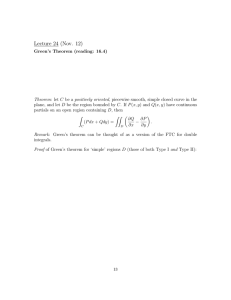SCHOENBERG’S THEOREM VIA THE LAW OF LARGE NUMBERS (NOT FOR PUBLICATION)
advertisement

SCHOENBERG’S THEOREM
VIA THE LAW OF LARGE NUMBERS
(NOT FOR PUBLICATION)
DAVAR KHOSHNEVISAN
Abstract. A classical theorem of S. Bochner states that a function f : Rn →
C is the Fourier transform of a finite Borel measure if and only if f is positive
definite. In 1938, I. Schoenberg found a beautiful complement to Bochner’s
theorem. We present a non-technical derivation of of Schoenberg’s theorem
that relies chiefly on the de Finetti theorem and the law of large numbers of
classical probability theory.
1. Introduction
A real-valued function g of n vectors is said to be positive semi-definite (somePk Pk
times, positive definite) if i=1 j=1 g(xi − xj )ci cj ≥ 0 for all n-vectors x1 , . . . , xk
and all complex numbers c1 , . . . , ck .
A classical theorem of S. Bochner (1955, Theorem 3.2.3, p. 58) asserts that
positive semi-definite functions are precisely those that are Fourier transforms of
finite measures. Let k · kn denote the usual Euclidean norm in n dimensions. That
is, kxkn = (x21 + · · · + x2n )1/2 for all x ∈ Rn . Then, the goal of this note is to present
a very simple proof of the following well-known theorem of I. J. Schoenberg (1938,
Theorem 2):
Schoenberg’s Theorem. Suppose f : R+ → R+ is continuous. Then, the following are equivalent:
(1) The function Rn 3 x 7→ f (kxkn ) is positive semi-definite.
√
(2) The function R+ 3 t 7→ f ( t) is the Laplace transform of a finite Borel
measure on R+ .
Originally, this theorem was used to describe isometric embeddings of Hilbert
spaces. Since its discovery, it has also found non-trivial connections to other diverse
areas ranging from classical, as well as abstract, harmonic analysis (Berg and Ressel, 1978; Berg et al., 1984; Kahane, 1985) to the measure theory of Banach spaces
Date: April 29, 2005.
1991 Mathematics Subject Classification. Primary. 60F-xx; Secondary. 43A35.
Key words and phrases. Schoenberg’s theorem, law of large numbers.
Research supported in part by a grant from NSF.
1
2
DAVAR KHOSHNEVISAN
(Bretagnolle et al., 1965; 1965/1966; Bretagnolle et al., 1967; Christensen and Ressel, 1982; Koldobsky, 1996; Misiewicz, 1996a; 1996b; Koldobsky, 1999; Koldobsky
and Lonke, 1999), function theory (Ressel, 1974; Diaconis and Freedman, 2004a;
2004b) and to the foundations of statistics via de Finetti-type theorems (Freedman,
1963; Ressel, 1985; Diaconis and Freedman, 2004a; 2004b). For other relations, in
particular, to statistical mechanics, see the detailed historical section of Diaconis
and Freedman (2004b).
Although Schoenberg’s original proof is not too difficult to follow, it is somewhat
technical. P. Ressel (1976) has devised a simpler proof which rests on a characterization of Laplace transforms (Ressel, 1974, Satz 1) that is similar to Schoenberg’s
theorem. We are aware also of another simple proof, due to J. Bretagnolle, D.
Dacuhna–Castelle, and J.-L. Krivine (1965; 1965/1966; 1967). Their proof is similar to the one presented here, but is slightly more technical.
The present article aims to describe a self-contained, elementary, and brief derivation of Schoenberg’s theorem. Our proof assumes only a brief acquaintance with
real analysis and measure-theoretic probability theory. This proof is quite robust
and can be used to produce more general results; all one needs is a more general
setting in which a basic form of the de Finetti theorem and the law of large numbers
hold.
Since writing the first draft of this paper, we have found out about the work of
D. Kelker (1970, Theorem 10). Kelker’s proof is essentially the same as ours. J.
Kingman (1972) contains yet another rediscovery of Kelker’s proof.
Acknowledgements. Christian Berg brought to my attention the recent work
of Steerneman and Perlo-ten Kleij (2005), and Paul Ressel made an important
correction to the original draft. I am deeply endebted to them both.
2. The Proof
All notation and references to probability theory are standard and can be found
in any standard first-year graduate textbook.
Without loss of generality, we may suppose that f (0) = 1. Then, thanks to
Bochner’s theorem, Schoenberg’s theorem translates to the equivalence of the following two assertions:
(1◦ ) For all n ≥ 1 there exists a Borel probability measure µn on Rn such that
v
u n
Z
uX
(2.1)
f t
x2 =
eix·y µn (dy) ∀ x := (x1 , . . . , xn ) ∈ Rn .
i
i=1
Rn
SCHOENBERG’S THEOREM
3
(2◦ ) There exists a Borel probability measure ν on R+ such that
Z ∞
2
∀
(2.2)
f (t) =
e−t s/2 ν(ds)
t > 0.
0
Therefore, it suffices to prove that (1◦ ) and (2◦ ) are equivalent. The assertion,
“(2◦ )⇒(1◦ )” follows from a direct computation because kxkn 7→ exp(−kxk2n s/2) is
manifestly a Fourier transform on Rn . So we prove only the converse. Henceforth,
we assume that (1◦ ) holds.
Our next lemma follows immediately from (1◦ ) and the uniqueness theorem.
Lemma 1. The family {µn }∞
n=1 is consistent.
It might help to recall that “{µn }∞
n=1 is consistent” means that for all n ≥ 1 and
all linear Borel sets A1 , A2 , . . . , µn (A1 × · · · × An ) = µn+1 (A1 × · · · An × R).
Proof of Schoenberg’s Theorem. In accord with Lemma 1 and the Kolmogorov consistency theorem, there exists an exchangeable stochastic process {Yk }∞
k=1 , on some
probability space (Ω, F , P), such that for all n ≥ 1 and all Borel sets A ⊂ Rn ,
(2.3)
P{(Y1 , . . . , Yn ) ∈ A} = µn (A).
Choose and fix some t > 0, and introduce a sequence {Xi }∞
i=1 of independent
random variables such that every Xi has the normal distribution with mean 0
and variance t2 . We can assume, without loss of generality, that the Xi ’s are
defined on the same probability space (Ω, F , P). We first apply (1◦ ) with x :=
n−1/2 (X1 , . . . , Xn ), and then take expectations, to deduce that for all n ≥ 1,
v
u n
2
Z
u1 X
t kyk2n
E f t
Xi2 =
exp −
µn (dy)
n i=1
2n
Rn
(2.4)
"
!#
n
t2 X 2
= E exp −
Y
.
2n i=1 i
See (2.3) for the last identity. Now let n → ∞. The simplest form of the law of
Pn
large numbers dictates that i=1 Xi2 /n → VarX1 = t2 in probability. Therefore,
the left-hand side of (2.4) converges to f (t) by the dominated convergence theorem.
By the de Finetti theorem, the Yi ’s are conditionally i.i.d. given the exchangeable σ-algebra generated by the Yi ’s. Thanks to the Kolmogorov strong law of
Pn
large numbers, and by the Fubini–theorem, L := limn→∞ n1 i=1 Yi2 exists a.s.
Moreover, the event {L < ∞} agrees upto null sets with {E[Y12 | E ] < ∞}, where
E denotes the exchangeable σ-algebra of {Yi }∞
i=1 . By the dominated convergence
theorem, the right-hand side of (2.4) converges to E[exp(−t2 L/2); L < ∞].
We have proved that f (t) = E[exp(−t2 L/2); L < ∞] for a possibly-degenerate
non-negative random variable L. Set t = 0 to find that L is a proper random
4
DAVAR KHOSHNEVISAN
variable; i.e., 1 = f (0) = P{L < ∞}. Therefore, (2◦ ) follows with ν denoting the
distribution of L.
References
Berg, Christian, Jens Peter Reus Christensen, and Paul Ressel. 1984. Harmonic Analysis on
Semigroups, Graduate Texts in Mathematics, vol. 100, Springer-Verlag, New York.
Berg, Christian and Paul Ressel. 1978. Une forme abstraite du théorème de Schoenberg, Arch.
Math. (Basel) 30(1), 55–61. (French)
Bochner, Salomon. 1955. Harmonic Analysis and the Theory of Probability, University of California Press, Berkeley and Los Angeles.
Bretagnolle, J., D. Dacunha-Castelle, and J.-L. Krivine. 1967. Lois stables et espaces Lp , Symposium on Probability Methods in Analysis (Loutraki, 1966), Springer, Berlin, pp. 48–54. (French)
Bretagnolle, Jean, Didier Dacunha-Castelle, and Jean-Louis Krivine. 1965/1966. Lois stables et
espaces Lp , Ann. Inst. H. Poincaré Sect. B (N.S.) 2, 231–259. (French)
. 1965. Fonctions de type positif sur les espaces Lp , C. R. Acad. Sci. Paris 261, 2153–2156.
(French)
Christensen, Jens Peter Reus and Paul Ressel. 1982. Positive definite kernels on the complex
Hilbert sphere, Math. Z. 180(2), 193–201.
Diaconis, Persi and David Freedman. 2004a. The Markov moment problem and de Finetti’s theorem. I , Math. Z. 247(1), 183–199.
. 2004b. The Markov moment problem and de Finetti’s theorem. II , Math. Z. 247(1),
201–212.
Freedman, David A. 1963. Invariants under mixing which generalize de Finetti’s theorem: Continuous time parameter , Ann. Math. Statist. 34, 1194–1216.
Kahane, Jean-Pierre. 1985. Some Random Series of Functions, 2nd ed., Cambridge University
Press, Cambridge.
Kelker, Douglas. 1970. Distribution theory of spherical distributions and a location-scale parameter
generalization, Sankhyā Ser. A 32, 419–438.
Kingman, J. F. C. 1972. On random sequences with spherical symmetry, Biometrika 59, 492–494.
Koldobsky, Alexander. 1999. Positive definite distributions and subspaces of L−p with applications
to stable processes, Canad. Math. Bull. 42(3), 344–353.
Koldobsky, Alexander and Yossi Lonke. 1999. A short proof of Schoenberg’s conjecture on positive
definite functions, Bull. London Math. Soc. 31(6), 693–699.
Koldobsky, Alexander. 1996. Positive definite functions, stable measures, and isometries on Banach spaces, Interaction between Functional Analysis, Harmonic Analysis, and Probability
(Columbia, MO, 1994), Lecture Notes in Pure and Appl. Math., vol. 175, Dekker, New York,
pp. 275–290.
Misiewicz, Jolanta K. 1996a. Substable and pseudo-isotropic processes—connections with the geometry of subspaces of Lα -spaces, Dissertationes Math. (Rozprawy Mat.) 358, 91.
. 1996b. Sub-stable and pseudo-isotropic processes—connections with the geometry of subspaces of Lα -spaces, Bull. Polish Acad. Sci. Math. 44(2), 209–235.
Ressel, Paul. 1985. De Finetti-type theorems: an analytical approach, Ann. Probab. 13(3), 898–
922.
. 1976. A short proof of Schoenberg’s theorem, Proc. Amer. Math. Soc. 57(1), 66–68.
SCHOENBERG’S THEOREM
5
. 1974. Laplace-Transformation nichtnegativer und vektorwertiger Maße, Manuscripta
Math. 13, 143–152. (German, with English summary)
Schoenberg, I. J. 1938. Metric spaces and completely monotone functions, Ann. of Math. (2)
39(4), 811–841.
Steerneman, A. G. M.@
@@ and Frederieke van Perlo-ten Kleij. 2005. Spherical distributions:
Schoenberg (1938) revisited, Expos. Math. (to appear).
144 S 1500 E, Department of Mathematics, The University of Utah, Salt Lake City
UT 84112–0090
E-mail address: davar@math.utah.edu
URL: http://www.math.utah.edu/ davar


